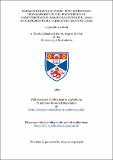Files in this item
Parasitological studies: post-embryonic development in the polycercus of paricterotaenia paradoxa (Rudolphi, 1802) in allolobophora terrestris (Savigny, 1826)
Item metadata
| dc.contributor.advisor | Burt, D. R. R. | |
| dc.contributor.author | Scott, James Stuart | |
| dc.coverage.spatial | 152 p. | en_US |
| dc.date.accessioned | 2018-06-26T13:36:17Z | |
| dc.date.available | 2018-06-26T13:36:17Z | |
| dc.date.issued | 1963 | |
| dc.identifier.uri | https://hdl.handle.net/10023/14618 | |
| dc.description.abstract | 1. Metchnikov's discovery of Polycerus lubrici in the Earthworm, made in 1867, is confirmed for the first time. 2. The conclusion of Joyeux and Baer that Polycercus lumbrici is the larval form of Paricterotaenia paradoxa (= Amoebotaenia lumbrici) is confirmed. 3. The intermediate host is identified as Allolobophora terrestris and the principal final host as the Woodcock (Scolopax rusticola). 4. The polycercus has been found only in immature specimens of A. terrestris. The implications of this are discussed. 5. Earthworms were experimentally infested with Polycercus lumbrici by feeding them with mature proglottides of Paricterotaenia Paradoxa from the Woodcock. 6. The incidence and habits of the Woodcock are discussed. 7. The degree and site of infestation of Paricterotaenia paradoxa in the Woodcock are discussed. 8. The development of Polycerous lumbrici in the Earthworm, from the earliest form of the larva to the cysticercoid, is described in detail for the first time. 9. MetchniRov's outline of the development of Polvcercus lumbrici is amended to include a retroversion of the larva prior to the differentiation of the primordia of the scolex, retention of the side-walls of the larva and the appearance of an axial column of cells. His account is also extended to give, for the first time, a complete description of the development of the scolex. The rostellum is formed, as in Cysticercus fasciolars, from a bulb and prebulb, the former supplying the hook-elevator muscles and the glandular elements, the latter the muscles of the walls of the rostellum and the hook-retractor muscles. The remainder of the muscles of the scolex are modifications of the parenchymal and peripheral musculature. 10. The muscular, excretory, nervous and glandular systems are described and discussed. 11. A description is given of experiments to determine: (i) suitable media for keeping the larvae alive in vitro; (ii) agents for freeing the cysticercoids from the cyst; (iii) agents which induce evagination of the scolex; (iv) suitable media for culture and development of the evaginated tapeworms. The results of the experiments indicate that: (i) the larvae can be kept alive for periods of up to five days in simple physiological solutions such as Locke's (ii) the larvae are freed from the cyst in the gizzard of the final host by a purely mechanical process; (iii) the larvae are induced to evaginate in the final host by the action of gastric juice followed by pancreatic juice, the effective agents being pepsin in the first and pancreatin in the second, (iv) the tapeworm will not develop to maturity in any of the media used. 12. The discovery of a second polycercus, the larval form of Paricterotaenla burti Sandeman, 1959 is recorded from the Earthworm Allolophora terrestris. 13. Hook development in Paricterotaenia burti is described it follows the same general pattern as that of P. paradoxa. 14. An unidentified species of Amoebotaenia is described. 15. Evidence is offered which elucidates the life-cycles of the following cestodes: (i) Paricterotaenia paradoxa: intermediate host, the Earthworm Allolobophora terrestris; final host, the Woodcock (Scolopax rusticola). (ii) Parieterotaenia burti; intermediate host, the Earthworm Allolobophora terrestris; final host, the Woodcock (Scolopax rustlcola). (iii) Paricterotaenia stelliferai: final host, various charadrriform birds; intermediate host, Tubifex. Cysticercus pachycanthus is identified as the larval form of Valipora skrjabini a parasite of the Common Snipe (Gallinago gallinago). An unrecorded cyrsticercoid from Tubifox is noted. | en_US |
| dc.language.iso | en | en_US |
| dc.publisher | University of St Andrews | |
| dc.subject.lcc | QL392.S3 | en |
| dc.subject.lcsh | Earthworms | en |
| dc.title | Parasitological studies: post-embryonic development in the polycercus of paricterotaenia paradoxa (Rudolphi, 1802) in allolobophora terrestris (Savigny, 1826) | en_US |
| dc.type | Thesis | en_US |
| dc.contributor.sponsor | Madras College (St. Andrews, Scotland) | en_US |
| dc.contributor.sponsor | Department of Scientific and Industrial Research (DSIR) | en_US |
| dc.type.qualificationlevel | Doctoral | en_US |
| dc.type.qualificationname | PhD Doctor of Philosophy | en_US |
| dc.publisher.institution | The University of St Andrews | en_US |
This item appears in the following Collection(s)
Items in the St Andrews Research Repository are protected by copyright, with all rights reserved, unless otherwise indicated.

